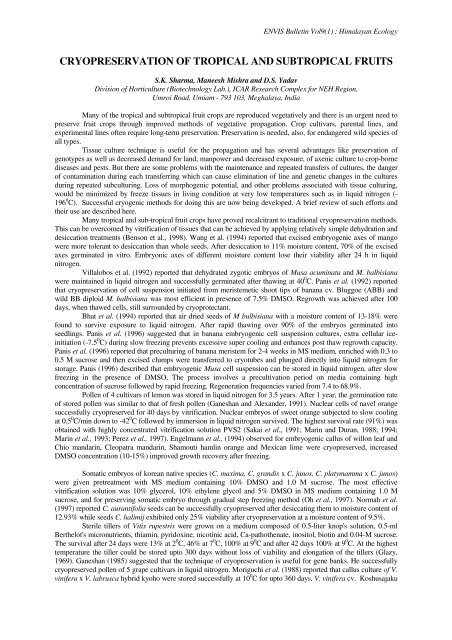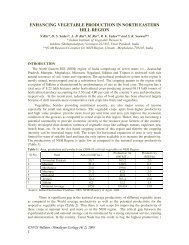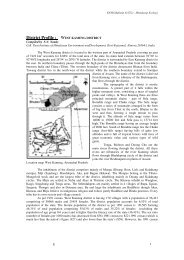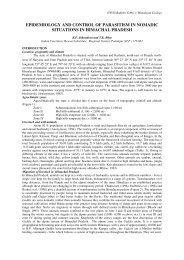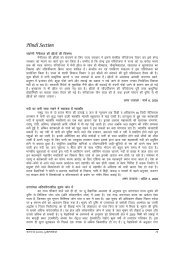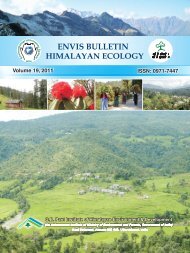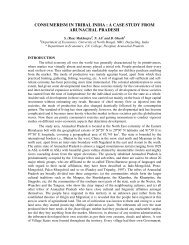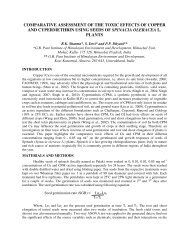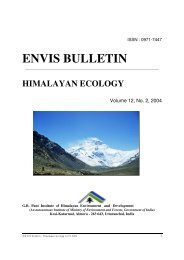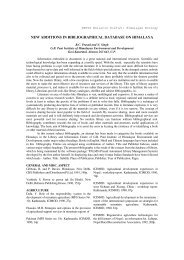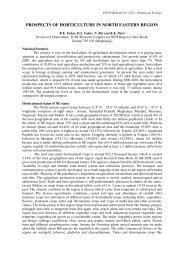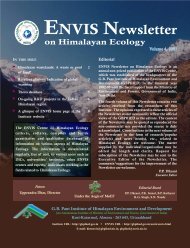cryopreservation of tropical and subtropical fruits - ENVIS Centre on ...
cryopreservation of tropical and subtropical fruits - ENVIS Centre on ...
cryopreservation of tropical and subtropical fruits - ENVIS Centre on ...
Create successful ePaper yourself
Turn your PDF publications into a flip-book with our unique Google optimized e-Paper software.
<str<strong>on</strong>g>ENVIS</str<strong>on</strong>g> Bulletin Vol9(1) : Himalayan EcologyCRYOPRESERVATION OF TROPICAL AND SUBTROPICAL FRUITSS.K. Sharma, Maneesh Mishra <str<strong>on</strong>g>and</str<strong>on</strong>g> D.S. YadavDivisi<strong>on</strong> <str<strong>on</strong>g>of</str<strong>on</strong>g> Horticulture (Biotechnology Lab.), ICAR Research Complex for NEH Regi<strong>on</strong>,Umroi Road, Umiam - 793 103, Meghalaya, IndiaMany <str<strong>on</strong>g>of</str<strong>on</strong>g> the <str<strong>on</strong>g>tropical</str<strong>on</strong>g> <str<strong>on</strong>g>and</str<strong>on</strong>g> sub<str<strong>on</strong>g>tropical</str<strong>on</strong>g> fruit crops are reproduced vegetatively <str<strong>on</strong>g>and</str<strong>on</strong>g> there is an urgent need topreserve fruit crops through improved methods <str<strong>on</strong>g>of</str<strong>on</strong>g> vegetative propagati<strong>on</strong>. Crop cultivars, parental lines, <str<strong>on</strong>g>and</str<strong>on</strong>g>experimental lines <str<strong>on</strong>g>of</str<strong>on</strong>g>ten require l<strong>on</strong>g-term preservati<strong>on</strong>. Preservati<strong>on</strong> is needed, also, for endangered wild species <str<strong>on</strong>g>of</str<strong>on</strong>g>all types.Tissue culture technique is useful for the propagati<strong>on</strong> <str<strong>on</strong>g>and</str<strong>on</strong>g> has several advantages like preservati<strong>on</strong> <str<strong>on</strong>g>of</str<strong>on</strong>g>genotypes as well as decreased dem<str<strong>on</strong>g>and</str<strong>on</strong>g> for l<str<strong>on</strong>g>and</str<strong>on</strong>g>, manpower <str<strong>on</strong>g>and</str<strong>on</strong>g> decreased exposure, <str<strong>on</strong>g>of</str<strong>on</strong>g> axenic culture to crop-bornediseases <str<strong>on</strong>g>and</str<strong>on</strong>g> pests. But there are some problems with the maintenance <str<strong>on</strong>g>and</str<strong>on</strong>g> repeated transfers <str<strong>on</strong>g>of</str<strong>on</strong>g> cultures, the danger<str<strong>on</strong>g>of</str<strong>on</strong>g> c<strong>on</strong>taminati<strong>on</strong> during each transferring which can cause eliminati<strong>on</strong> <str<strong>on</strong>g>of</str<strong>on</strong>g> line <str<strong>on</strong>g>and</str<strong>on</strong>g> genetic changes in the culturesduring repeated subculturing. Loss <str<strong>on</strong>g>of</str<strong>on</strong>g> morphogenic potential, <str<strong>on</strong>g>and</str<strong>on</strong>g> other problems associated with tissue culturing,would be minimized by freeze tissues in living c<strong>on</strong>diti<strong>on</strong> at very low temperatures such as in liquid nitrogen (-196 0 C). Successful cryogenic methods for doing this are now being developed. A brief review <str<strong>on</strong>g>of</str<strong>on</strong>g> such efforts <str<strong>on</strong>g>and</str<strong>on</strong>g>their use are described here.Many <str<strong>on</strong>g>tropical</str<strong>on</strong>g> <str<strong>on</strong>g>and</str<strong>on</strong>g> sub-<str<strong>on</strong>g>tropical</str<strong>on</strong>g> fruit crops have proved recalcitrant to traditi<strong>on</strong>al <str<strong>on</strong>g>cryopreservati<strong>on</strong></str<strong>on</strong>g> methods.This can be overcomed by vitrificati<strong>on</strong> <str<strong>on</strong>g>of</str<strong>on</strong>g> tissues that can be achieved by applying relatively simple dehydrati<strong>on</strong> <str<strong>on</strong>g>and</str<strong>on</strong>g>desiccati<strong>on</strong> treatments (Bens<strong>on</strong> et al., 1998). Wang et al. (1994) reported that excised embryogenic axes <str<strong>on</strong>g>of</str<strong>on</strong>g> mangowere more tolerant to desiccati<strong>on</strong> than whole seeds. After desiccati<strong>on</strong> to 11% moisture c<strong>on</strong>tent, 70% <str<strong>on</strong>g>of</str<strong>on</strong>g> the excisedaxes germinated in vitro. Embry<strong>on</strong>ic axes <str<strong>on</strong>g>of</str<strong>on</strong>g> different moisture c<strong>on</strong>tent lose their viability after 24 h in liquidnitrogen.Villalobos et al. (1992) reported that dehydrated zygotic embryos <str<strong>on</strong>g>of</str<strong>on</strong>g> Musa acuminata <str<strong>on</strong>g>and</str<strong>on</strong>g> M. balbisianawere maintained in liquid nitrogen <str<strong>on</strong>g>and</str<strong>on</strong>g> successfully germinated after thawing at 40 0 C. Panis et al. (1992) reportedthat <str<strong>on</strong>g>cryopreservati<strong>on</strong></str<strong>on</strong>g> <str<strong>on</strong>g>of</str<strong>on</strong>g> cell suspensi<strong>on</strong> initiated from meristemetic shoot tips <str<strong>on</strong>g>of</str<strong>on</strong>g> banana cv. Bluggoe (ABB) <str<strong>on</strong>g>and</str<strong>on</strong>g>wild BB diploid M. balbisiana was most efficient in presence <str<strong>on</strong>g>of</str<strong>on</strong>g> 7.5% DMSO. Regrowth was achieved after 100days, when thawed cells, still surrounded by cryoprotectant.Bhat et al. (1994) reported that air dried seeds <str<strong>on</strong>g>of</str<strong>on</strong>g> M bulbisiana with a moisture c<strong>on</strong>tent <str<strong>on</strong>g>of</str<strong>on</strong>g> 13-18% werefound to survive exposure to liquid nitrogen. After rapid thawing over 90% <str<strong>on</strong>g>of</str<strong>on</strong>g> the embryos germinated intoseedlings. Panis et al. (1996) suggested that in banana embryogenic cell suspensi<strong>on</strong> cultures, extra cellular iceinitiati<strong>on</strong>(-7.5 0 C) during slow freezing prevents excessive super cooling <str<strong>on</strong>g>and</str<strong>on</strong>g> enhances post thaw regrowth capacity.Panis et al. (1996) reported that preculturing <str<strong>on</strong>g>of</str<strong>on</strong>g> banana meristem for 2-4 weeks in MS medium, enriched with 0.3 to0.5 M sucrose <str<strong>on</strong>g>and</str<strong>on</strong>g> then excised clumps were transferred to cryotubes <str<strong>on</strong>g>and</str<strong>on</strong>g> plunged directly into liquid nitrogen forstorage. Panis (1996) described that embryogenic Musa cell suspensi<strong>on</strong> can be stored in liquid nitrogen, after slowfreezing in the presence <str<strong>on</strong>g>of</str<strong>on</strong>g> DMSO. The process involves a precultivati<strong>on</strong> period <strong>on</strong> media c<strong>on</strong>taining highc<strong>on</strong>centrati<strong>on</strong> <str<strong>on</strong>g>of</str<strong>on</strong>g> sucrose followed by rapid freezing. Regenerati<strong>on</strong> frequencies varied from 7.4 to 68.9%.Pollen <str<strong>on</strong>g>of</str<strong>on</strong>g> 4 cultivars <str<strong>on</strong>g>of</str<strong>on</strong>g> lem<strong>on</strong> was stored in liquid nitrogen for 3.5 years. After 1 year, the germinati<strong>on</strong> rate<str<strong>on</strong>g>of</str<strong>on</strong>g> stored pollen was similar to that <str<strong>on</strong>g>of</str<strong>on</strong>g> fresh pollen (Ganeshan <str<strong>on</strong>g>and</str<strong>on</strong>g> Alex<str<strong>on</strong>g>and</str<strong>on</strong>g>er, 1991). Nuclear cells <str<strong>on</strong>g>of</str<strong>on</strong>g> navel orangesuccessfully cryopreserved for 40 days by vitrificati<strong>on</strong>. Nuclear embryos <str<strong>on</strong>g>of</str<strong>on</strong>g> sweet orange subjected to slow coolingat 0.5 0 C/min down to -42 0 C followed by immersi<strong>on</strong> in liquid nitrogen survived. The highest survival rate (91%) wasobtained with highly c<strong>on</strong>centrated vitrificati<strong>on</strong> soluti<strong>on</strong> PVS2 (Sakai et al., 1991; Marin <str<strong>on</strong>g>and</str<strong>on</strong>g> Duran, 1988; 1994;Marin et al., 1993; Perez et al., 1997). Engelmann et al., (1994) observed for embryogenic callus <str<strong>on</strong>g>of</str<strong>on</strong>g> will<strong>on</strong> leaf <str<strong>on</strong>g>and</str<strong>on</strong>g>Chio m<str<strong>on</strong>g>and</str<strong>on</strong>g>arin, Cleopatra m<str<strong>on</strong>g>and</str<strong>on</strong>g>arin, Shamouti hamlin orange <str<strong>on</strong>g>and</str<strong>on</strong>g> Mexican lime were cryopreserved, increasedDMSO c<strong>on</strong>centrati<strong>on</strong> (10-15%) improved growth recovery after freezing.Somatic embryos <str<strong>on</strong>g>of</str<strong>on</strong>g> korean native species (C. maxima, C. gr<str<strong>on</strong>g>and</str<strong>on</strong>g>is x C. junos, C. platymamma x C. junos)were given pretreatment with MS medium c<strong>on</strong>taining 10% DMSO <str<strong>on</strong>g>and</str<strong>on</strong>g> 1.0 M sucrose. The most effectivevitrificati<strong>on</strong> soluti<strong>on</strong> was 10% glycerol, 10% ethylene glycol <str<strong>on</strong>g>and</str<strong>on</strong>g> 5% DMSO in MS medium c<strong>on</strong>taining 1.0 Msucrose, <str<strong>on</strong>g>and</str<strong>on</strong>g> for preserving somatic embryo through gradual step freezing method (Oh et al., 1997). Normah et al.(1997) reported C. aurantifolia seeds can be successfully cryopreserved after desiccating them to moisture c<strong>on</strong>tent <str<strong>on</strong>g>of</str<strong>on</strong>g>12.93% while seeds C. halimij exhibited <strong>on</strong>ly 25% viability after <str<strong>on</strong>g>cryopreservati<strong>on</strong></str<strong>on</strong>g> at a moisture c<strong>on</strong>tent <str<strong>on</strong>g>of</str<strong>on</strong>g> 9.5%.Sterile tillers <str<strong>on</strong>g>of</str<strong>on</strong>g> Vitis rupestris were grown <strong>on</strong> a medium composed <str<strong>on</strong>g>of</str<strong>on</strong>g> 0.5-liter knop's soluti<strong>on</strong>, 0.5-mlBerthelot's micr<strong>on</strong>utrients, thiamin, pyridoxine, nicotinic acid, Ca-pathothenate, inositol, biotin <str<strong>on</strong>g>and</str<strong>on</strong>g> 0.04-M sucrose.The survival after 24 days were 13% at 2 0 C, 46% at 7 0 C, 100% at 9 0 C <str<strong>on</strong>g>and</str<strong>on</strong>g> after 42 days 100% at 9 0 C. At the highesttemperature the tiller could be stored upto 300 days without loss <str<strong>on</strong>g>of</str<strong>on</strong>g> viability <str<strong>on</strong>g>and</str<strong>on</strong>g> el<strong>on</strong>gati<strong>on</strong> <str<strong>on</strong>g>of</str<strong>on</strong>g> the tillers (Glazy,1969). Ganeshan (1985) suggested that the technique <str<strong>on</strong>g>of</str<strong>on</strong>g> <str<strong>on</strong>g>cryopreservati<strong>on</strong></str<strong>on</strong>g> is useful for gene banks. He successfullycryopreserved pollen <str<strong>on</strong>g>of</str<strong>on</strong>g> 5 grape cultivars in liquid nitrogen. Moriguchi et al. (1988) reported that callus culture <str<strong>on</strong>g>of</str<strong>on</strong>g> V.vinifera x V. labrusca hybrid kyoho were stored successfully at 10 0 C for upto 360 days. V. vinifera cv. Koshusajaku
<str<strong>on</strong>g>ENVIS</str<strong>on</strong>g> Bulletin Vol9(1) : Himalayan Ecologycallus survived storage at both 10 <str<strong>on</strong>g>and</str<strong>on</strong>g> 13 0 C for 360 days when silic<strong>on</strong>e was added to the medium.Finkle et al. (1979) <str<strong>on</strong>g>and</str<strong>on</strong>g> Ulrich et al. (1979) have investigated the possibility <str<strong>on</strong>g>of</str<strong>on</strong>g> freeze c<strong>on</strong>servati<strong>on</strong> <str<strong>on</strong>g>of</str<strong>on</strong>g> a<str<strong>on</strong>g>tropical</str<strong>on</strong>g> palm tree, date palm (Phoenix dactylifera L.). Tisserat et al. (1985) reported that cryopreserved pollen <str<strong>on</strong>g>of</str<strong>on</strong>g>date palm or Deglet Noor dusted <strong>on</strong> freshly opened spathes <str<strong>on</strong>g>of</str<strong>on</strong>g> 10 years old Deglet Noor. Fruit yield <str<strong>on</strong>g>and</str<strong>on</strong>g>developments were similar in both frozen <str<strong>on</strong>g>and</str<strong>on</strong>g> n<strong>on</strong>-frozen pollen. Bagniol et al. (1992) suggested that for<str<strong>on</strong>g>cryopreservati<strong>on</strong></str<strong>on</strong>g> <str<strong>on</strong>g>of</str<strong>on</strong>g> date palm, gradients may be exhibited both for outflow <str<strong>on</strong>g>of</str<strong>on</strong>g> water <str<strong>on</strong>g>and</str<strong>on</strong>g> the penetrati<strong>on</strong> <str<strong>on</strong>g>of</str<strong>on</strong>g> thecryoprotectants. MyCock et al. (1997) reported late globular/early tarpedo stage date palm (Phoenix dactylifera)embryos can c<strong>on</strong>tinue normal growth <str<strong>on</strong>g>and</str<strong>on</strong>g> development after <str<strong>on</strong>g>cryopreservati<strong>on</strong></str<strong>on</strong>g> provided they are pretreated with acryoprotectant mixture <str<strong>on</strong>g>of</str<strong>on</strong>g> glycerol <str<strong>on</strong>g>and</str<strong>on</strong>g> sucrose <str<strong>on</strong>g>and</str<strong>on</strong>g> then dried to water c<strong>on</strong>tents in the range <str<strong>on</strong>g>of</str<strong>on</strong>g> 0.4 - 0.7 g/g. Mater(1987) reported callus <str<strong>on</strong>g>of</str<strong>on</strong>g> date palm was treated with a cryoprotective mixture <str<strong>on</strong>g>of</str<strong>on</strong>g> PEG, glucose <str<strong>on</strong>g>and</str<strong>on</strong>g> DMSO <str<strong>on</strong>g>and</str<strong>on</strong>g>frozen to -25 0 C for 4 m<strong>on</strong>ths. Freezing did not affect the potential <str<strong>on</strong>g>of</str<strong>on</strong>g> the callus for embryogenesis although growthduring the first 2 m<strong>on</strong>ths <str<strong>on</strong>g>of</str<strong>on</strong>g> culture was inhibited.Yakuwa <str<strong>on</strong>g>and</str<strong>on</strong>g> Oka (1988) reported that either prefreezing <str<strong>on</strong>g>of</str<strong>on</strong>g> intact vegetative bud <str<strong>on</strong>g>of</str<strong>on</strong>g> mulberry at -10 0 C or20 0 C followed by rapid thawing at 37 0 C or prefreezing at -20 0 C or 30 0 C followed by slow thawing at 0 0 C gave highpercentage <str<strong>on</strong>g>of</str<strong>on</strong>g> survival. Embry<strong>on</strong>ic axes <str<strong>on</strong>g>of</str<strong>on</strong>g> l<strong>on</strong>ger seeds with moisture c<strong>on</strong>tent <str<strong>on</strong>g>of</str<strong>on</strong>g> 18% survived after 24 h in liquidnitrogen (Fu et al., 1993). Fukai et al. (1994) reported shoot tips <str<strong>on</strong>g>of</str<strong>on</strong>g> Parsimm<strong>on</strong> (Diospyros kaki) prec<strong>on</strong>diti<strong>on</strong>ed <strong>on</strong>medium c<strong>on</strong>taining 15 g sucrose/liter <str<strong>on</strong>g>and</str<strong>on</strong>g> stored at 10 0 C. Shoot explants survived for 30 weeks at 10 0 C.REFERENCESBangniol, S., Engelmann, F. <str<strong>on</strong>g>and</str<strong>on</strong>g> Michaux, F.N. 1992. Histo-cytological study <str<strong>on</strong>g>of</str<strong>on</strong>g> apices from in vitro plantlets <str<strong>on</strong>g>of</str<strong>on</strong>g>date palm (Phoenix dactylifera L.) during a <str<strong>on</strong>g>cryopreservati<strong>on</strong></str<strong>on</strong>g> process. Cryoletters. 13 (6): 405-412.Bens<strong>on</strong>, E.E., Lynch, P.T. <str<strong>on</strong>g>and</str<strong>on</strong>g> Stacey, G.N. 1998. Advances in plant <str<strong>on</strong>g>cryopreservati<strong>on</strong></str<strong>on</strong>g> technology: currentapplicati<strong>on</strong> in crop plant biotechnology. Ag-Biotechnology News <str<strong>on</strong>g>and</str<strong>on</strong>g> Informati<strong>on</strong>. 10(5): 133-141.Bhat, S.R., Bhat, K.H. <str<strong>on</strong>g>and</str<strong>on</strong>g> Ch<str<strong>on</strong>g>and</str<strong>on</strong>g>el, K.P.S. 1994. Studies <strong>on</strong> germinati<strong>on</strong> <str<strong>on</strong>g>and</str<strong>on</strong>g> <str<strong>on</strong>g>cryopreservati<strong>on</strong></str<strong>on</strong>g> <str<strong>on</strong>g>of</str<strong>on</strong>g> Musa balbisianaseed. Seed Science <str<strong>on</strong>g>and</str<strong>on</strong>g> Technology. 22(3): 637-640.Engelmann, F., Dambier, D. <str<strong>on</strong>g>and</str<strong>on</strong>g> Ollitrault, P. 1994. Cryopreservati<strong>on</strong> <str<strong>on</strong>g>of</str<strong>on</strong>g> cell suspensi<strong>on</strong>s <str<strong>on</strong>g>and</str<strong>on</strong>g> embryogenic calluses<str<strong>on</strong>g>of</str<strong>on</strong>g> citrus using a simplified freezing process. Cryoletters. 15(1): 53-58.Finkle, B.J., Ulrich, J.M., Rains, D.W., Tisserat, B.B. <str<strong>on</strong>g>and</str<strong>on</strong>g> Schaefer, G.W. 1979. Survival <str<strong>on</strong>g>of</str<strong>on</strong>g> alfalfa, Medicagosativa, rice Oryza sativa <str<strong>on</strong>g>and</str<strong>on</strong>g> date palm Phoenix dactylifera, callus after liquid nitrogen freezing.Cryobiology. 16: 583.Fu, J.R., Xia, Q.H. <str<strong>on</strong>g>and</str<strong>on</strong>g> Tang, L.F. 1993. Effects <str<strong>on</strong>g>of</str<strong>on</strong>g> desiccati<strong>on</strong> <strong>on</strong> excised embry<strong>on</strong>ic axes <str<strong>on</strong>g>of</str<strong>on</strong>g> three recalcitrant seeds<str<strong>on</strong>g>and</str<strong>on</strong>g> studies <strong>on</strong> <str<strong>on</strong>g>cryopreservati<strong>on</strong></str<strong>on</strong>g>.Seed Science <str<strong>on</strong>g>and</str<strong>on</strong>g> Technology. 21(1): 85-95.Fukui, H., Ohba, H. <str<strong>on</strong>g>and</str<strong>on</strong>g> Nakamura, M. 1994. Low temperature storage <str<strong>on</strong>g>of</str<strong>on</strong>g> in vitro shoots <str<strong>on</strong>g>of</str<strong>on</strong>g> Japanese persimm<strong>on</strong>(Diospyros kaki). Proc. Internati<strong>on</strong>al Plant Propagators Society. 44 : 245-248.Ganeshan, S. 1985. Cryogenic preservati<strong>on</strong> <str<strong>on</strong>g>of</str<strong>on</strong>g> Irape (Vitis vinifera L.) pollen. Vitis 24(3) : 169-173.Ganeshan, S. <str<strong>on</strong>g>and</str<strong>on</strong>g> Alex<str<strong>on</strong>g>and</str<strong>on</strong>g>er, M.P. 1991. Cryogenic preservati<strong>on</strong> <str<strong>on</strong>g>of</str<strong>on</strong>g> lem<strong>on</strong> (Citrus lim<strong>on</strong> Burm.) pollen.Gartenbauwissenschaft. 56(5) : 228-230.Glazy, R. 1969. Recherches sur la croissance de Vitis rupestris scheele sain et court noue cultive in vitro adifferentes temperatures. Ann. Phytopathol. 1 : 49-166.Marin, M.L. <str<strong>on</strong>g>and</str<strong>on</strong>g> Duran, V.N. 1988. Survival <str<strong>on</strong>g>of</str<strong>on</strong>g> somatic embryos <str<strong>on</strong>g>and</str<strong>on</strong>g> recovery <str<strong>on</strong>g>of</str<strong>on</strong>g> plants <str<strong>on</strong>g>of</str<strong>on</strong>g> sweet orange (Citrussinensis (L.) Osb.) after immersi<strong>on</strong> in liquid nitrogen. Plant Cell, Tissue <str<strong>on</strong>g>and</str<strong>on</strong>g> Organ Culture. 14(1) : 51-57.Marin, M.L. <str<strong>on</strong>g>and</str<strong>on</strong>g> Duran, Villa N. 1994. Cryopreservati<strong>on</strong> <str<strong>on</strong>g>of</str<strong>on</strong>g> somatic embryos <str<strong>on</strong>g>of</str<strong>on</strong>g> Washingt<strong>on</strong> Navel Sweet Orange.7th Internati<strong>on</strong>al Citrus C<strong>on</strong>gress, Acireale, Italy. 313-317.Marin, M.L., Gogorcena, Y., Ortiz, J. <str<strong>on</strong>g>and</str<strong>on</strong>g> Duran, V.N. 1993. Recovery <str<strong>on</strong>g>of</str<strong>on</strong>g> whole plants <str<strong>on</strong>g>of</str<strong>on</strong>g> sweet orange fromsomatic embryos subjected to freezing thawing treatments. Plant Cell Tissue <str<strong>on</strong>g>and</str<strong>on</strong>g> Organ Culture. 34(1) : 27-33.Mater, A.A. 1987. Producti<strong>on</strong> <str<strong>on</strong>g>and</str<strong>on</strong>g> cryogenic freezing <str<strong>on</strong>g>of</str<strong>on</strong>g> date palm germplasm <str<strong>on</strong>g>and</str<strong>on</strong>g> regenerati<strong>on</strong> <str<strong>on</strong>g>of</str<strong>on</strong>g> plantlets fromfrozen material. Iraqi Journal <str<strong>on</strong>g>of</str<strong>on</strong>g> Agricultural Sciences `ZANCO' 5 (supplement) : 35-49.Moriguchi, T., Kozaki, I., Matsuta, N. <str<strong>on</strong>g>and</str<strong>on</strong>g> Yamaki, S. 1988. Plant regenerati<strong>on</strong> from grape callus stored under acombinati<strong>on</strong> <str<strong>on</strong>g>of</str<strong>on</strong>g> low temperature <str<strong>on</strong>g>and</str<strong>on</strong>g> silic<strong>on</strong>e treatment. Plant Cell, Tissue <str<strong>on</strong>g>and</str<strong>on</strong>g> Organ Culture. 15(1) : 67-71.MyCock, D.J., Berjak, P., Pammenter, N.W., Vertucci, C.W., Ellis, R.H., Black, M., Murdoch, A.J. <str<strong>on</strong>g>and</str<strong>on</strong>g> H<strong>on</strong>g, T.D.1997. Cryopreservati<strong>on</strong> <str<strong>on</strong>g>of</str<strong>on</strong>g> somatic embryoids <str<strong>on</strong>g>of</str<strong>on</strong>g> Phoenix dactylifera. Current Plant Science <str<strong>on</strong>g>and</str<strong>on</strong>g>Biotechnology in Agriculture No. 30.Normah, M.N., Siti Dewi Serimala, M.N., Ellis, R.H., Black, M., Murdoch, A.J. <str<strong>on</strong>g>and</str<strong>on</strong>g> H<strong>on</strong>g, T.D. 1997.Cryopreservati<strong>on</strong> <str<strong>on</strong>g>of</str<strong>on</strong>g> seeds <str<strong>on</strong>g>and</str<strong>on</strong>g> embry<strong>on</strong>ic axes <str<strong>on</strong>g>of</str<strong>on</strong>g> several citrus species. Current Science <str<strong>on</strong>g>and</str<strong>on</strong>g> Biotechnologyin Agriculture No.30.Oh, Sung Do, Oh, S.D., Altman, A. <str<strong>on</strong>g>and</str<strong>on</strong>g> Ziv, M. 1997. The effect <str<strong>on</strong>g>of</str<strong>on</strong>g> prefreezing treatment <str<strong>on</strong>g>and</str<strong>on</strong>g> cryoprotectants <strong>on</strong> thesurvival <str<strong>on</strong>g>of</str<strong>on</strong>g> cryopreserved somatic embryos <str<strong>on</strong>g>and</str<strong>on</strong>g> plant regenrati<strong>on</strong> in Korean native citrus species. ActaHorticulturae. No. 447 : 499-505.Panis, B. 1996. Cryopreservati<strong>on</strong> <str<strong>on</strong>g>of</str<strong>on</strong>g> banana (Musa spp.) germplasm. Bull. Des Seances Academic Royale des
<str<strong>on</strong>g>ENVIS</str<strong>on</strong>g> Bulletin Vol9(1) : Himalayan EcologySciences d. outre Mer. 42(3) : 521-535.Panis, B., Dhed-a-D., Swennen, R., Adams, R.P. <str<strong>on</strong>g>and</str<strong>on</strong>g> Adams, J.E. 1992. Freeze-preservati<strong>on</strong> <str<strong>on</strong>g>of</str<strong>on</strong>g> embryogenic Musasuspensi<strong>on</strong> cultures. C<strong>on</strong>servati<strong>on</strong> <str<strong>on</strong>g>of</str<strong>on</strong>g> plant genes : DNA banking <str<strong>on</strong>g>and</str<strong>on</strong>g> in vitro biotechnology. 183-195.Panis, B., Totte, N. Nimmen, K. Van, Withers, L.A., Swennen, R. <str<strong>on</strong>g>and</str<strong>on</strong>g> Van, N.K. 1996. Cryopreservati<strong>on</strong> <str<strong>on</strong>g>of</str<strong>on</strong>g> banana(Musa spp.) meristem cultures after preculture <strong>on</strong> sucrose. Plant Science Limerick. 121(1) : 95-106.Perez, R.M., Navarro, L. <str<strong>on</strong>g>and</str<strong>on</strong>g> Duran, V.N. 1997. Cryopreservati<strong>on</strong> <str<strong>on</strong>g>and</str<strong>on</strong>g> storage <str<strong>on</strong>g>of</str<strong>on</strong>g> embryogenic callus cultures <str<strong>on</strong>g>of</str<strong>on</strong>g>several citrus species <str<strong>on</strong>g>and</str<strong>on</strong>g> cultivars. Plant Cell Reports. 17(1) : 44-49.Sakai, A., Kobayashi, S. <str<strong>on</strong>g>and</str<strong>on</strong>g> Oiyama, I. 1991. Survival by vitrificati<strong>on</strong> <str<strong>on</strong>g>of</str<strong>on</strong>g> nucellar cells <str<strong>on</strong>g>of</str<strong>on</strong>g> navel orange (Citrussinensis var. brasiliensis Tanaka) cooled to -196 0 C. Journal <str<strong>on</strong>g>of</str<strong>on</strong>g> Plant Physiology. 137(4) : 465-470.Tisserat, B., Gabr, M.F. <str<strong>on</strong>g>and</str<strong>on</strong>g> Sabour, M.T. 1985. Vaibility <str<strong>on</strong>g>of</str<strong>on</strong>g> cryogenically treated date palm pollen. Date PalmJournal. 4(1) : 25-31.Ulrich, J.M., Finkle, B.J., Moore, P.H. <str<strong>on</strong>g>and</str<strong>on</strong>g> Ginoza, H. 1979. Effect <str<strong>on</strong>g>of</str<strong>on</strong>g> a mixture <str<strong>on</strong>g>of</str<strong>on</strong>g> cryoprotectants in attaining liquidnitrogen survival <str<strong>on</strong>g>of</str<strong>on</strong>g> cells. Fiziol. Rast. 15 : 749-756.Villalobos, V.M., Abbelnour, A., Adams, R.P. <str<strong>on</strong>g>and</str<strong>on</strong>g> Adams, J.E. 1992. Cryopreservati<strong>on</strong> <str<strong>on</strong>g>of</str<strong>on</strong>g> Musa spp. <str<strong>on</strong>g>and</str<strong>on</strong>g>potential for l<strong>on</strong>g-term storage <str<strong>on</strong>g>of</str<strong>on</strong>g> other <str<strong>on</strong>g>tropical</str<strong>on</strong>g> crops. C<strong>on</strong>servati<strong>on</strong> <str<strong>on</strong>g>of</str<strong>on</strong>g> plant genes : DNA banking <str<strong>on</strong>g>and</str<strong>on</strong>g> invitro biotechnology. 197-210.Wang, XiaoFeng; Fu, JiaRui; Wang, X.F. <str<strong>on</strong>g>and</str<strong>on</strong>g> Fu, J.R. 1994. Desiccati<strong>on</strong> <str<strong>on</strong>g>and</str<strong>on</strong>g> <str<strong>on</strong>g>cryopreservati<strong>on</strong></str<strong>on</strong>g> <str<strong>on</strong>g>of</str<strong>on</strong>g> excised embry<strong>on</strong>icaxes <str<strong>on</strong>g>of</str<strong>on</strong>g> mango seeds. Journal <str<strong>on</strong>g>of</str<strong>on</strong>g> South China Agricultural Univ. 15(3) : 88-92.Yakuwa, H. <str<strong>on</strong>g>and</str<strong>on</strong>g> Oka, S. 1988. Plant regenerati<strong>on</strong> through meristem culture from vegetative buds <str<strong>on</strong>g>of</str<strong>on</strong>g> mulberry(Morus bombycis Koidz.) stored in liquid nitrogen. Annals <str<strong>on</strong>g>of</str<strong>on</strong>g> Botany. 62(1) : 79-82.Summary <str<strong>on</strong>g>of</str<strong>on</strong>g> completed/<strong>on</strong>going projects, funded by IERP, GBPIHEDits


